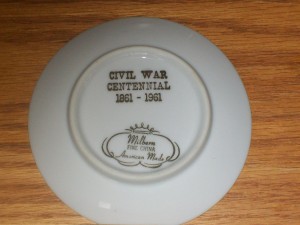Made in America
Knowing of our interest in the Civil War, a friend recently gave us a small plate commemorating the centennial of the conflict.
It is a typical souvenir, probably purchased at a battlefield gift shop. Its front shows a cannon, representing warfare, and an American flag, symbolic of the preservation of the union. The back announces that the piece is “American Made,” a fact replete with its own special symbolism.
When the Civil War erupted in 1861, the Industrial Revolution was already impacting Americans. Steam-powered river boats, ships, and locomotives cut transportation time. Steam also powered mills and looms which, when coupled with the sewing machine, an 1847 invention, gave rise to the garment industry, one of the first to offer employment to large numbers of women.
When pioneers found their cast iron plows unsuitable for tilling the deep topsoil of the prairie, an impoverished blacksmith in Illinois made a steel plow share in 1837. His invention proved popular, but he could make only a few plows a year using imported English steel. In the 1850’s, when he was able to obtain quality steel from foundries in Pittsburgh, his annual production mushroomed to 1,600 plows. His name was John Deere.
After the war, the Industrial Revolution helped the nation rebuild and expand. The interests of inventors, entrepreneurs, and industrialists intersected to weave the fabric of a great nation. Carnegie’s steel made skyscrapers possible; Otis’s elevators made them practical. Rockefeller oil, Goodyear rubber, and Ford’s assembly line helped spawn the auto industry. Edison called upon Corning glass to build the envelope for his light bulbs, but Westinghouse shaped the industry with his preferance for alternating current. Alexander Graham Bell’s telephone added a magical dimension to communication, and George Eastman’s cameras made preserving memories a family affair.
Indeed, the hundred years following the Civil War may easily be labeled the American Made Era. I see that little dish as symbolizing both the hundredth anniversary of the War between the States and a century of achievement for the nation.
As the war’s Sesquicentennial nears, I wonder if “American Made” will be on the back of my next souvenir.
What you can do:
- Learn about Civil War Sesquecentennial activities in your area by checking your local media or going on line. One of the many excellent sites is www.civilwar.org/150th-anniversary.
- Attend an event, buy a souvenir, and turn it over—
